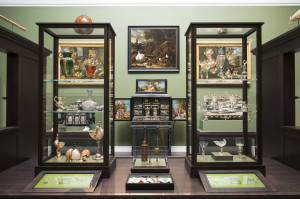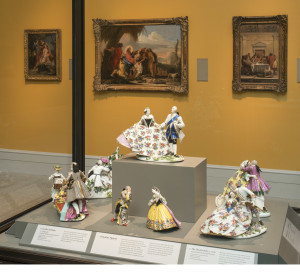A Rejuvenated Wadsworth Atheneum
When the Wadsworth Atheneum Museum of Art opened its doors on September 19th, visitors entered a museum that for the first time in 50 years had all of its galleries open. In fact, 17 new galleries greeted patrons, adding 16,000 square feet of exhibition space to the museum’s existing footprint.
Rather than accomplishing this through a major addition, the Wadsworth’s leadership chose to focus on improving and reconfiguring the space within five connected buildings. This approach preserved the integrity of the institution’s architectural heritage and overall scale, in particular the signature gothic-revival Morgan Memorial Building. Embracing these constraints led the curatorial staff to reexamine display practices. In doing so, they returned to the roots of public museum displays, embracing salon-style hanging of art and the conspicuous abundance of cabinets of curiosities.
Walking through the new galleries is not so much an overview of the progression of academic art history, but rather, as New York Times art critic Roberta Smith put it, “a beautifully arranged, vividly illustrated Cliffs Notes of Western culture.” Thematic displays of paintings bridge the gaps between continents and sometimes time periods, juxtaposing, for example, Giovanni Paolo Panini’s “The Picture Gallery of Cardinal Silvio Valenti Gonzaga” of 1749 with John Pasmore II’s portrayal of Benjamin West’s picture gallery from circa 1821.
The decorative arts hold their own within this setting. Curators arranged installations and cabinets for objects that complement or comment (sometimes humorously) on what hangs on the walls. In the late baroque gallery, for instance, the precise positioning of the painted figures in the mythological and religious paintings speaks to their significance within the work’s theological or moral message. The porcelain figurines in the nearby cabinet feature gestures, clothing, and gazes no less precise than those of their framed counterparts, but in a more worldly context that demonstrates their situation in society.
The Cabinet of Art and Curiosities on the second floor deserves particular mention. Much like the salon style hanging in the Great Hall, this display combines works of art from different cultures and time periods. Pull-out drawers store light-sensitive or small objects for casual perusal, while new interactive digital displays allow patrons to learn more about items that interest them. Using the Wadsworth’s new mobile application, they can save object records to their own unique digital collections.
As the oldest continuously operating art museum, the Wadsworth can add this year’s Grand Reopening to its long list of institutional accomplishments. “It is thrilling, on the eve of my retirement to look at what we as a team have accomplished over the last five years of renovation,” said Susan L. Talbott, Director and C.E.O. “I am confident that when I leave the Wadsworth Atheneum at the end of this year the museum will be poised to serve the next generation of visitors and staff.”
Decorative Arts Trust members participating in January’s New York V.I.P. Weekend will be able to see samples of the Wadsworth’s astounding collection for themselves at the Winter Antiques Show. The show’s 2016 loan exhibition Legacy for the Future: Wadsworth Atheneum Museum of Art celebrates the museum’s collection and vision.
SAVE THE DATE
- Special Symposium
“Classical Splendor”
The Philadelphia Museum of Art
November 4, 2016 - New York Antiques Weekend
January 20-21, 2017 - Spring Symposium
Savannah
April 21-24, 2017 - Spring Study Trip Abroad
Scotland
May 14-22, 2017 - Fall Symposium
Hartford & Western Connecticut
September 2017 - Fall Study Trip Abroad
Venice and the Veneto
October 9-16 and 22-29, 2017
When the Wadsworth Atheneum Museum of Art opened its doors on September 19th, visitors entered a museum that for the first time in 50 years had all of its galleries open. In fact, 17 new galleries greeted patrons, adding 16,000 square feet of exhibition space to the museum’s existing footprint.
Rather than accomplishing this through a major addition, the Wadsworth’s leadership chose to focus on improving and reconfiguring the space within five connected buildings. This approach preserved the integrity of the institution’s architectural heritage and overall scale, in particular the signature gothic-revival Morgan Memorial Building. Embracing these constraints led the curatorial staff to reexamine display practices. In doing so, they returned to the roots of public museum displays, embracing salon-style hanging of art and the conspicuous abundance of cabinets of curiosities.
Walking through the new galleries is not so much an overview of the progression of academic art history, but rather, as New York Times art critic Roberta Smith put it, “a beautifully arranged, vividly illustrated Cliffs Notes of Western culture.” Thematic displays of paintings bridge the gaps between continents and sometimes time periods, juxtaposing, for example, Giovanni Paolo Panini’s “The Picture Gallery of Cardinal Silvio Valenti Gonzaga” of 1749 with John Pasmore II’s portrayal of Benjamin West’s picture gallery from circa 1821.
The decorative arts hold their own within this setting. Curators arranged installations and cabinets for objects that complement or comment (sometimes humorously) on what hangs on the walls. In the late baroque gallery, for instance, the precise positioning of the painted figures in the mythological and religious paintings speaks to their significance within the work’s theological or moral message. The porcelain figurines in the nearby cabinet feature gestures, clothing, and gazes no less precise than those of their framed counterparts, but in a more worldly context that demonstrates their situation in society.
The Cabinet of Art and Curiosities on the second floor deserves particular mention. Much like the salon style hanging in the Great Hall, this display combines works of art from different cultures and time periods. Pull-out drawers store light-sensitive or small objects for casual perusal, while new interactive digital displays allow patrons to learn more about items that interest them. Using the Wadsworth’s new mobile application, they can save object records to their own unique digital collections.
As the oldest continuously operating art museum, the Wadsworth can add this year’s Grand Reopening to its long list of institutional accomplishments. “It is thrilling, on the eve of my retirement to look at what we as a team have accomplished over the last five years of renovation,” said Susan L. Talbott, Director and C.E.O. “I am confident that when I leave the Wadsworth Atheneum at the end of this year the museum will be poised to serve the next generation of visitors and staff.”
Decorative Arts Trust members participating in January’s New York V.I.P. Weekend will be able to see samples of the Wadsworth’s astounding collection for themselves at the Winter Antiques Show. The show’s 2016 loan exhibition Legacy for the Future: Wadsworth Atheneum Museum of Art celebrates the museum’s collection and vision.


